The Mantle Structure of North China Craton and Its Tectonic Implications: Insights from Teleseismic P-Wave Tomography
Abstract
:1. Introduction
2. Data and Methods
3. Results
3.1. Checkerboard Resolution Tests
3.2. P-Wave Tomographic Model
3.3. Synthetic Resolution Tests
4. Discussion
5. Conclusions
Supplementary Materials
Author Contributions
Funding
Data Availability Statement
Acknowledgments
Conflicts of Interest
References
- Zhao, G.; Wilde, S.A.; Cawood, P.A.; Sun, M. Archean Blocks and Their Boundaries in the North China Craton: Lithological, Geochemical, Structural and P–T Path Constraints and Tectonic Evolution. Precambrian Res. 2001, 107, 45–73. [Google Scholar] [CrossRef]
- Zhang, K.; Cai, J.; Zhu, J. North China and South China Collision: Insights from Analogue Modeling. J. Geodyn. 2006, 42, 38–51. [Google Scholar] [CrossRef]
- Oh, C.W. A New Concept on Tectonic Correlation between Korea, China and Japan: Histories from the Late Proterozoic to Cretaceous. Gondwana Res. 2006, 9, 47–61. [Google Scholar] [CrossRef]
- Rogers, J.J.W.; Santosh, M. Continents and Supercontinents; Oxford University Press, Inc.: Oxford, UK, 2004; ISBN 0-19-516589-6. [Google Scholar]
- Zhang, Y.; Dong, S. Mesozoic Tectonic Evolution History of the Tan-Lu Fault Zone: Advances and New Understanding. Geol. Bull. China 2008, 27, 1371–1390. [Google Scholar]
- Replumaz, A.; Tapponnier, P. Reconstruction of the Deformed Collision Zone between India and Asia by Backward Motion of Lithospheric Blocks. J. Geophys. Res. Solid Earth 2003, 108, 2285. [Google Scholar] [CrossRef]
- Li, S.; Li, X.; Wang, G.; Liu, Y.; Wang, Z.; Wang, T.; Cao, X.; Guo, X.; Somerville, I.; Li, Y.; et al. Global Meso-Neoproterozoic Plate Reconstruction and Formation Mechanism for Precambrian Basins: Constraints from Three Cratons in China. Earth Sci. Rev. 2019, 198, 102946. [Google Scholar] [CrossRef]
- Chen, L.; Tao, W.; Zhao, L.; Zheng, T. Distinct Lateral Variation of Lithospheric Thickness in the Northeastern North China Craton. Earth Planet. Sci. Lett. 2008, 267, 56–68. [Google Scholar] [CrossRef]
- Chen, L. Lithospheric Structure Variations between the Eastern and Central North China Craton from S- and P-Receiver Function Migration. Phys. Earth Planet. Inter. 2009, 173, 216–227. [Google Scholar] [CrossRef]
- Zheng, T.; Duan, Y.; Xu, W.; Ai, Y.; Chen, L.; Zhao, L.; Zhang, Y.; Xu, X. A Crust-Upper Mantle Seismic Wave Velocity Structure Model for North China, Version 2.0. 2017. Available online: http://www.craton.cn/data (accessed on 1 June 2021).
- Jiang, M. Local Modification of the Lithosphere beneath the Central and Western North China Craton: 3-D Constraints from Rayleigh Wave Tomography. Gondwana Res. 2013, 24, 849–864. [Google Scholar] [CrossRef]
- Xu, X.; Zhao, L.; Wang, K.; Yang, J. Indication from Finite-Frequency Tomography beneath the North China Craton: The Heterogeneity of Craton Destruction. Sci. China Earth Sci. 2018, 61, 1238–1260. [Google Scholar] [CrossRef]
- Zhu, R.; Chen, L.; Wu, F.; Liu, J. Timing, scale and mechanism of the destruction of the North China Craton. Sci. China Earth Sci. 2011, 41, 583–592. [Google Scholar] [CrossRef]
- Zhu, R.; Yang, J.; Wu, F. Timing of Destruction of the North China Craton. Lithos 2012, 149, 51–60. [Google Scholar] [CrossRef]
- Wu, F.; Xu, Y.; Zhu, R.; Zhang, G. Thinning and destruction of the cratonic lithosphere: A global perspective. Sci. China Earth Sci. 2014, 44, 2358–2372. [Google Scholar] [CrossRef]
- Tian, Y.; Zhao, D.; Sun, R.; Teng, J. Seismic Imaging of the Crust and Upper Mantle beneath the North China Craton. Phys. Earth Planet. Inter. 2009, 172, 169–182. [Google Scholar] [CrossRef]
- Northrup, C.J.; Royden, L.H.; Burchfiel, B.C. Motion of the Pacific Plate Relative to Eurasia and Its Potential Relation to Cenozoic Extension along the Eastern Margin of Eurasia. Geology 1995, 23, 719. [Google Scholar] [CrossRef]
- Huang, J.; Zhao, D. High-resolution Mantle Tomography of China and Surrounding Regions. J. Geophys. Res. Solid Earth 2006, 111, 2005JB004066. [Google Scholar] [CrossRef]
- Xu, X.; Ma, X. Geodynamics of the Shanxi Rift System, China. Tectonophysics 1992, 208, 325–340. [Google Scholar] [CrossRef]
- Liu, M.; Cui, X.; Liu, F. Cenozoic Rifting and Volcanism in Eastern China: A Mantle Dynamic Link to the Indo–Asian Collision? Tectonophysics 2004, 393, 29–42. [Google Scholar] [CrossRef]
- Feng, J.K.; Yao, H.J.; Chen, L.; Li, C.L. Ongoing Lithospheric Alteration of the North China Craton Revealed by Surface-Wave Tomography and Geodetic Observations. Geophys. Res. Lett. 2022, 49, e2022GL099403. [Google Scholar] [CrossRef]
- Zhang, Y.; Ma, Y.; Yang, N.; Shi, W.; Dong, S. Cenozoic Extensional Stress Evolution in North China. J. Geodyn. 2003, 36, 591–613. [Google Scholar] [CrossRef]
- Liu, R.; Chen, W.; Sun, J.; Li, D. The K–Ar Age and Tectonic Environment of Cenozoic Volcanic Rock in China; The Age and Geochemistry of Cenozoic Volcanic Rocks in China; Seismological Press: Beijing, China, 1992; ISBN 7-5028-0624-5. [Google Scholar]
- Lei, J. Upper-mantle Tomography and Dynamics beneath the North China Craton. J. Geophys. Res. Solid Earth 2012, 117, 2012JB009212. [Google Scholar] [CrossRef]
- Ma, J.; Tian, Y.; Zhao, D.; Liu, C.; Liu, T. Mantle Dynamics of Western Pacific and East Asia: New Insights from P Wave Anisotropic Tomography. Geochem. Geophys. Geosyst. 2019, 20, 3628–3658. [Google Scholar] [CrossRef]
- Zhao, L.; Allen, R.M.; Zheng, T.; Zhu, R. High-resolution Body Wave Tomography Models of the Upper Mantle beneath Eastern China and the Adjacent Areas. Geochem. Geophys. Geosyst. 2012, 13, 2012GC004119. [Google Scholar] [CrossRef]
- VanDecar, J.C.; Crosson, R.S. Determination of Teleseismic Relative Phase Arrival Times Using Multi-Channel Cross-Correlation and Least Squares. Bull. Seismol. Soc. Am. 1990, 80, 150–169. [Google Scholar]
- Kennett, B.L.N.; Engdahl, E.R. Traveltimes for Global Earthquake Location and Phase Identification. Geophys. J. Int. 1991, 105, 429–465. [Google Scholar] [CrossRef]
- VanDecar, J.C. Upper-Mantle Structure of the Cascadia Subduction Zone from Non-Linear Teleseismic Travel Time Inversion. Ph.D. Thesis, Univeristy of Washington, Seattle, WA, USA, 1991. [Google Scholar]
- Wang, W.; Wu, J.; Fang, L. High Resolution Rayleigh Wave Phase Velocity Tomography in Northern North China. Geophys. J. Int. 2012, 189, 647–658. [Google Scholar] [CrossRef]
- Xu, X.; Li, G.; Ding, Z.; Huang, X. S-Wave Velocity Structure of the Crust and Upper Mantle beneath the North China Craton Determined by Joint Inversion of Rayleigh-Wave Phase Velocity and Z/H Ratio. Seismol. Res. Lett. 2022, 93, 2176–2188. [Google Scholar] [CrossRef]
- Ekström, G.; Dziewonski, A.M. The Unique Anisotropy of the Pacific Upper Mantle. Nature 1998, 394, 168–172. [Google Scholar] [CrossRef]
- Li, C.; Van Der Hilst, R.D.; Toksöz, M.N. Constraining P-Wave Velocity Variations in the Upper Mantle beneath Southeast Asia. Phys. Earth Planet. Inter. 2006, 154, 180–195. [Google Scholar] [CrossRef]
- Xu, P.; Zhao, D. Upper-Mantle Velocity Structure beneath the North China Craton: Implications for Lithospheric Thinning. Geophys. J. Int. 2009, 177, 1279–1283. [Google Scholar] [CrossRef]
- Hu, G.; Teng, J.; He, Z.; Ding, Z. A Traveltime Tomography Study by Teleseismic S Wave Data in the Northeastern Part of North China Craton. Chin. J. Geophys. 2017, 60, 1703–1712. [Google Scholar] [CrossRef]
- Chen, L.; Jiang, M.; Yang, J.; Wei, Z.; Liu, C.; Ling, Y. Presence of an Intralithospheric Discontinuity in the Central and Western North China Craton: Implications for Destruction of the Craton. Geology 2014, 42, 223–226. [Google Scholar] [CrossRef]
- Cai, Y.; Wu, J.; Rietbrock, A.; Wang, W.; Fang, L.; Yi, S.; Liu, J. S Wave Velocity Structure of the Crust and Upper Mantle Beneath Shanxi Rift, Central North China Craton and Its Tectonic Implications. Tectonics 2021, 40, e2020TC006239. [Google Scholar] [CrossRef]
- Griffin, B.; Andi, Z.; O’Reilly, S.; Ryan, C. Phanerozoic Evolution of the Lithosphere beneath the Sino-Korean Craton. In Mantle Dynamics and Plate Interactions in East Asia; Amer Geophysical Union: Washington, DC, USA, 1998; pp. 107–126. ISBN 0-87590-529-3. [Google Scholar]
- Menzies, M.A.; Fan, W.; Zhang, M. Palaeozoic and Cenozoic Lithoprobe and the Loss of >120 km of Archean Lithosphere, Sino-Korean Craton, China. In Magmatic Processes and Plate Tectonics; Geological Society, London, Special Publications: London, UK, 1993; Volume 76, pp. 71–81. [Google Scholar]
- Liu, Q.; He, J. Tectono-Thermal Modeling of the Bohai Bay Basin since the Cenozoic. Chin. J. Geophys. 2019, 62, 219–235. [Google Scholar] [CrossRef]
- Zhang, F.; Li, Y.; Wu, Q.; Ding, Z. The P Wave Velocity Structure of Upper Mantle beneath the North China and Surrounding Regions from FMTT. Chin. J. Geophys. 2011, 54, 1233–1242. [Google Scholar] [CrossRef]
- Jiang, G.; Hu, S.; Shi, Y.; Zhang, C.; Wang, Z.; Hu, D. Terrestrial Heat Flow of Continental China: Updated Dataset and Tectonic Implications. Tectonophysics 2019, 753, 36–48. [Google Scholar] [CrossRef]
- Hu, S.; He, L.; Wang, J. Heat Flow in the Continental Area of China: A New Data Set. Earth Planet. Sci. Lett. 2000, 179, 407–419. [Google Scholar] [CrossRef]
- Sun, M.; Gao, S.S.; Liu, K.H.; Fu, X. Upper Mantle and Mantle Transition Zone Thermal and Water Content Anomalies beneath NE Asia: Constraints from Receiver Function Imaging of the 410 and 660 Km Discontinuities. Earth Planet. Sci. Lett. 2020, 532, 116040. [Google Scholar] [CrossRef]
- Xu, X. New Constraints on Structures of the Mantle Transition Zone beneath the Trans-North China Orogen and Western North China Craton Revealed by Receiver Functions. J. Asian Earth Sci. 2023, 245, 105554. [Google Scholar] [CrossRef]
- Su, P.; He, H.; Tan, X.; Liu, Y.; Shi, F.; Kirby, E. Initiation and Evolution of the Shanxi Rift System in North China: Evidence From Low-Temperature Thermochronology in a Plate Reconstruction Framework. Tectonics 2021, 40, e2020TC006298. [Google Scholar] [CrossRef]
- Yin, A.; Kapp, P.A.; Murphy, M.A.; Manning, C.E.; Mark Harrison, T.; Grove, M.; Lin, D.; Xi-Guang, D.; Cun-Ming, W. Significant Late Neogene East-West Extension in Northern Tibet. Geology 1999, 27, 787. [Google Scholar] [CrossRef]
- Li, S.; Guo, Z.; Chen, Y.J.; Yang, Y.; Huang, Q. Lithospheric Structure of the Northern Ordos From Ambient Noise and Teleseismic Surface Wave Tomography. J. Geophys. Res. Solid Earth 2018, 123, 6940–6957. [Google Scholar] [CrossRef]
- Wessel, P.; Luis, J.F.; Uieda, L.; Scharroo, R.; Wobbe, F.; Smith, W.H.F.; Tian, D. The Generic Mapping Tools Version 6. Geochem. Geophys. Geosyst. 2019, 20, 5556–5564. [Google Scholar] [CrossRef]
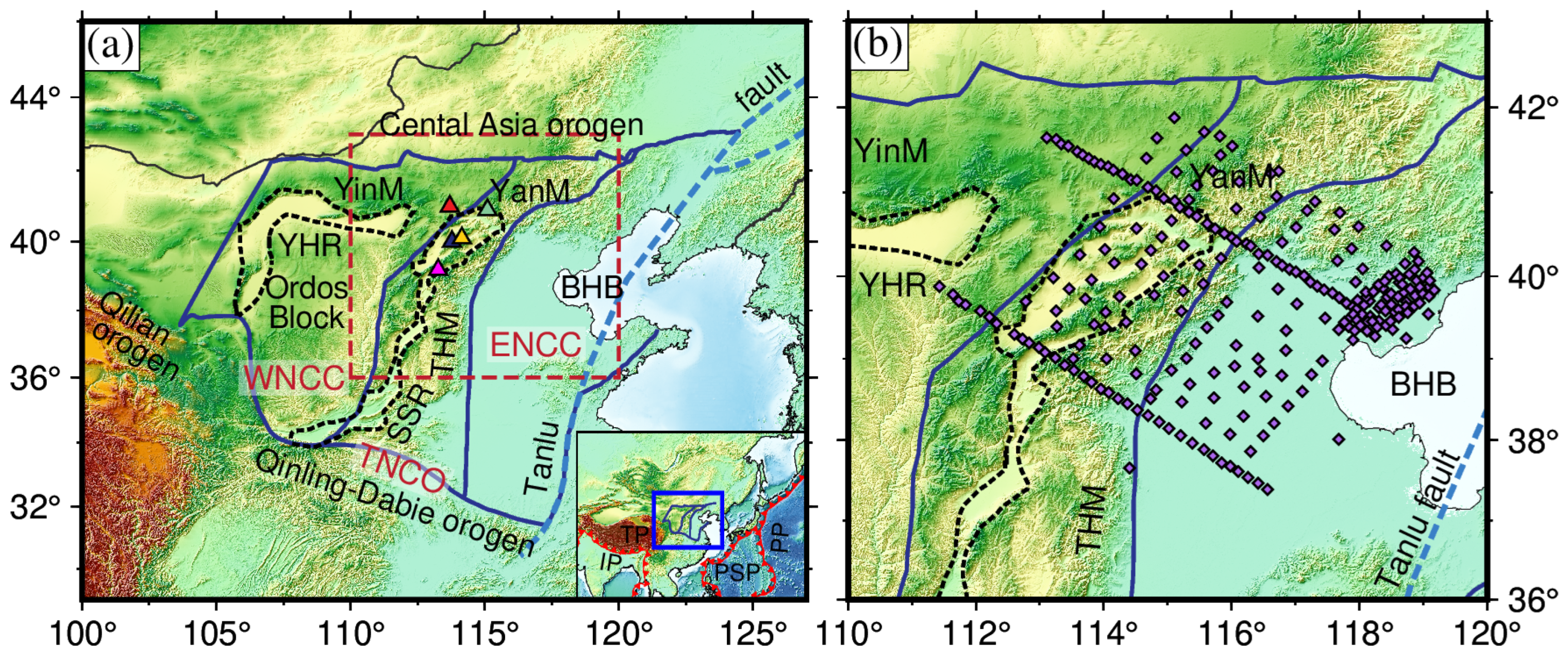
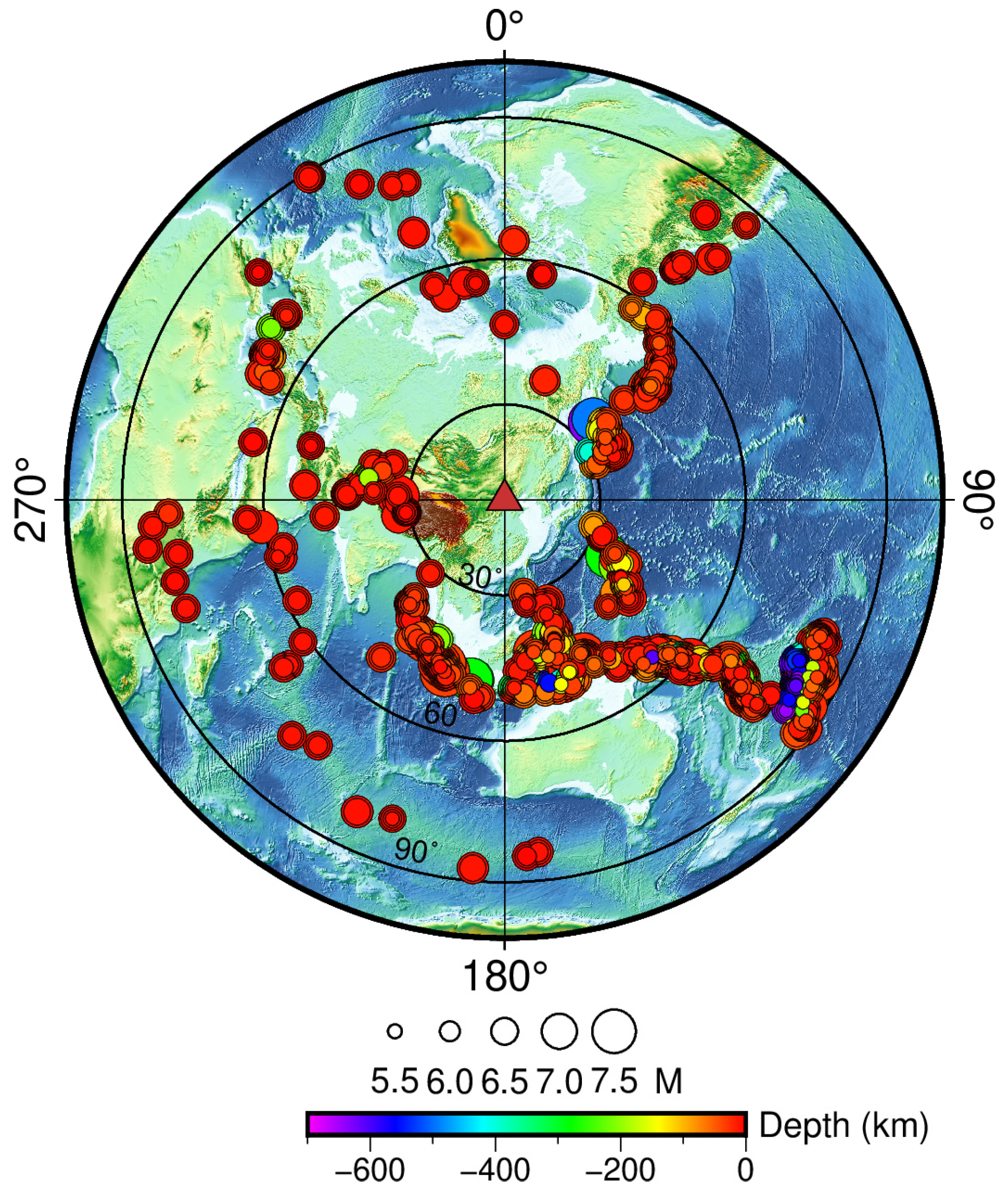
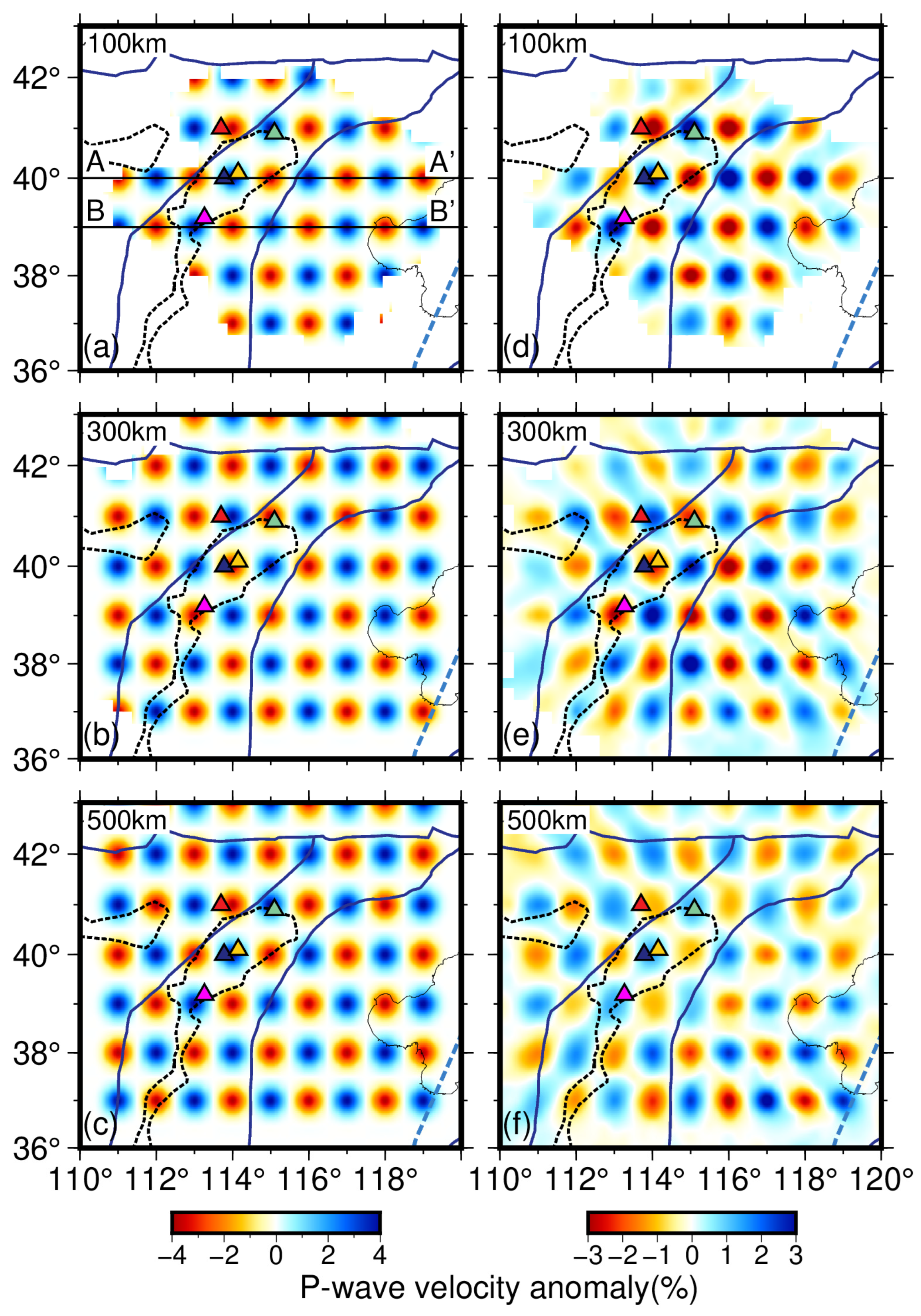
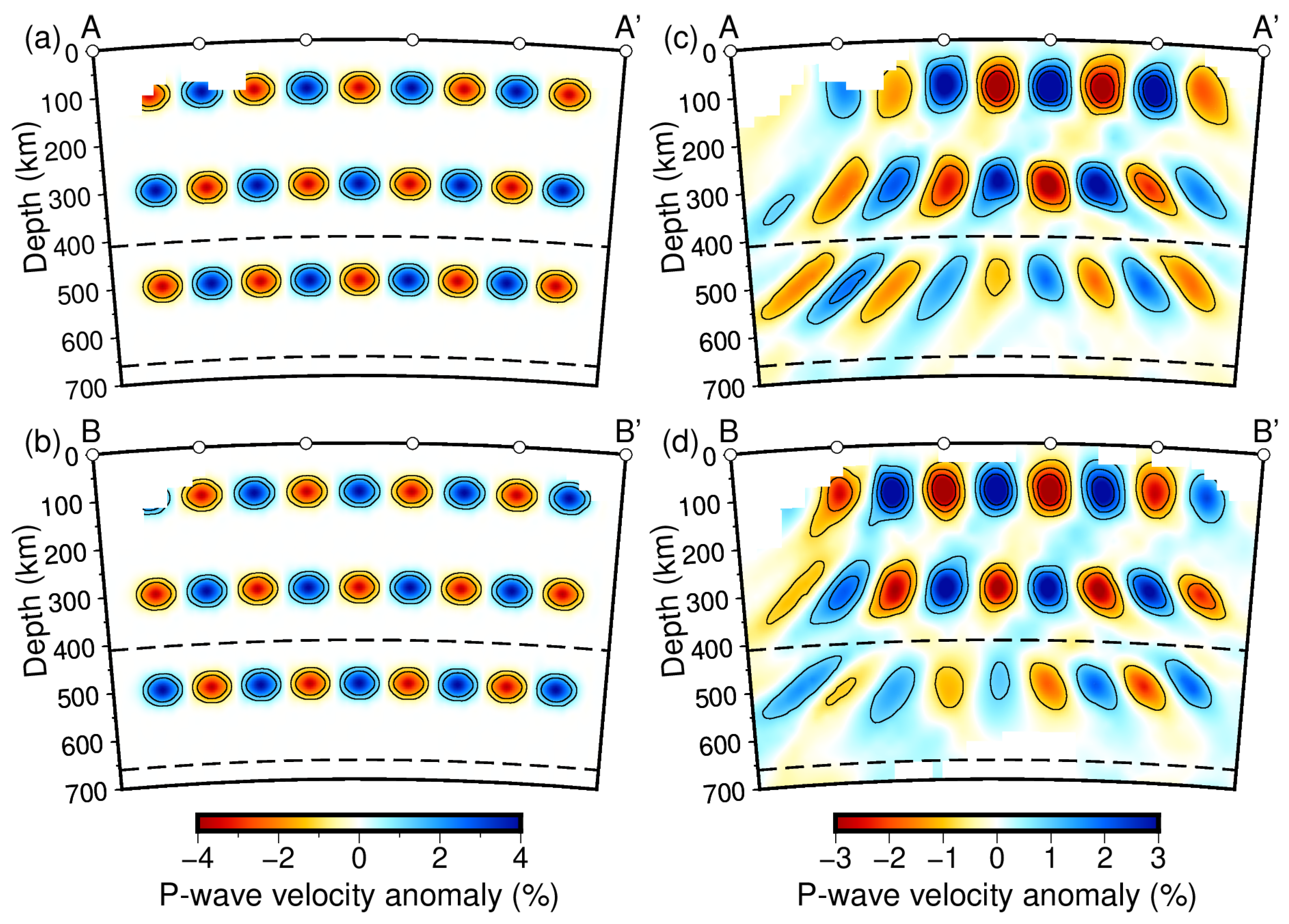
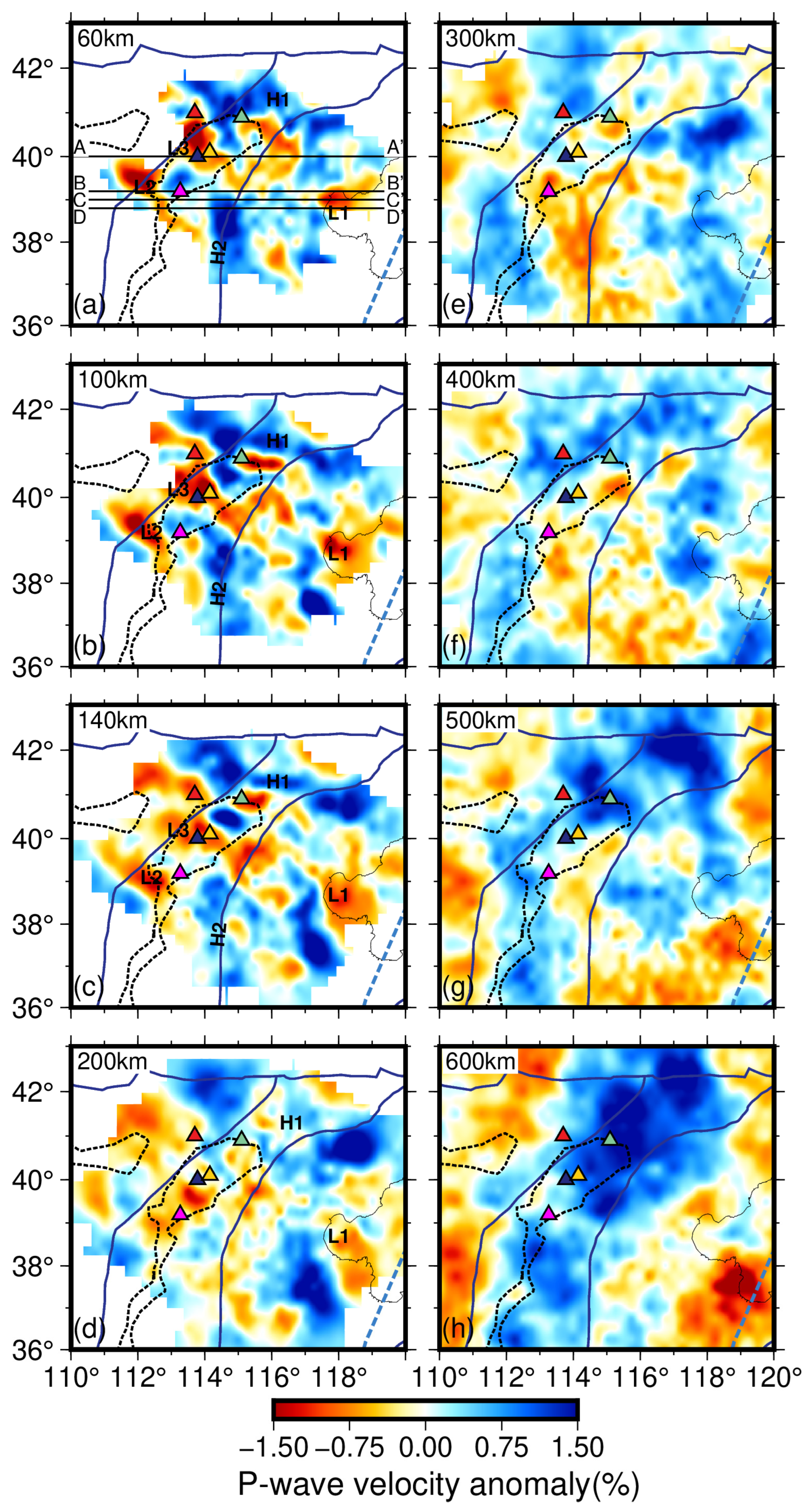

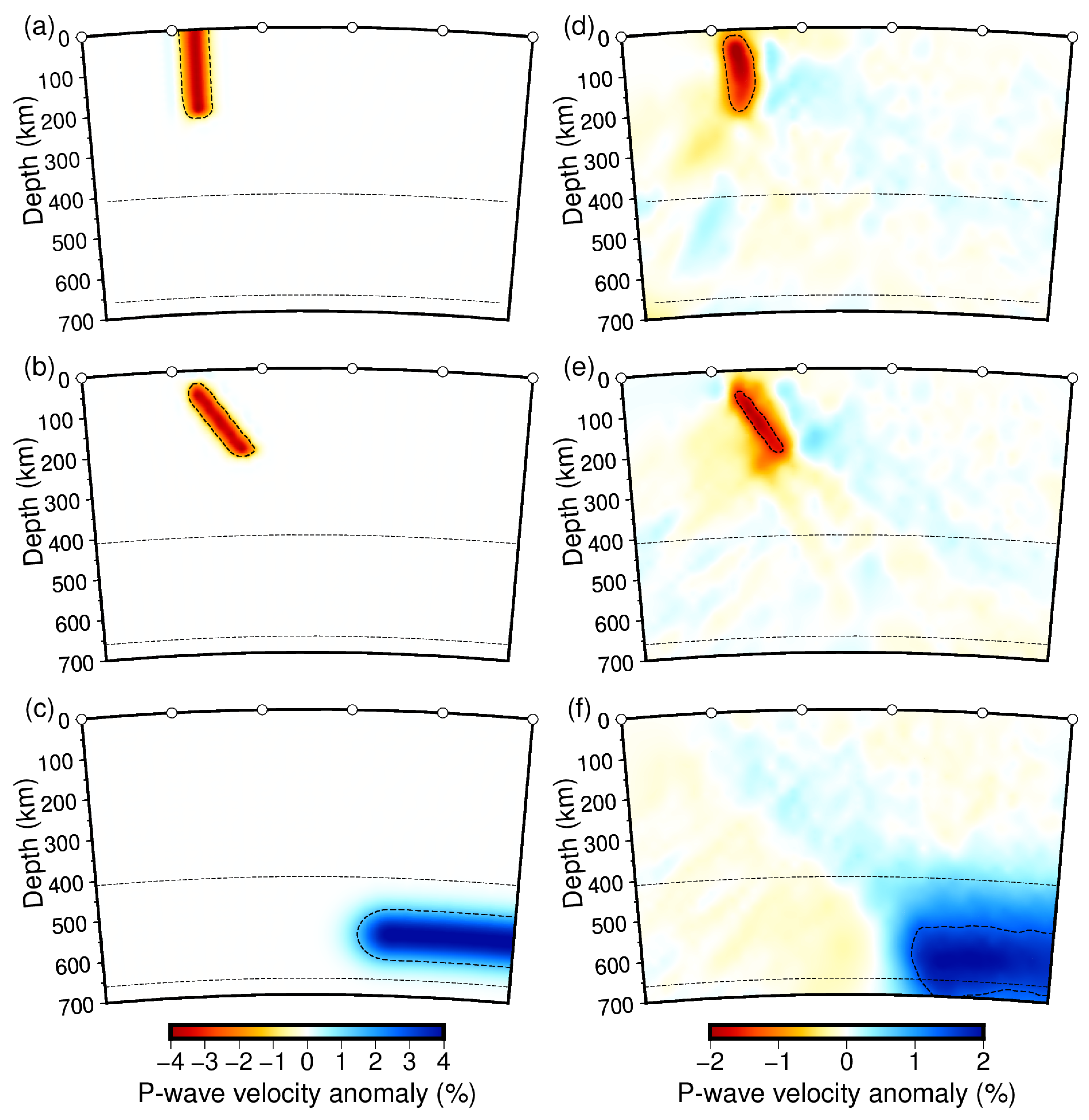
Disclaimer/Publisher’s Note: The statements, opinions and data contained in all publications are solely those of the individual author(s) and contributor(s) and not of MDPI and/or the editor(s). MDPI and/or the editor(s) disclaim responsibility for any injury to people or property resulting from any ideas, methods, instructions or products referred to in the content. |
© 2025 by the authors. Licensee MDPI, Basel, Switzerland. This article is an open access article distributed under the terms and conditions of the Creative Commons Attribution (CC BY) license (https://creativecommons.org/licenses/by/4.0/).
Share and Cite
Yu, W.; Wei, W.; Hammond, J.O.S.; Han, C.; Tan, H.; Hao, H. The Mantle Structure of North China Craton and Its Tectonic Implications: Insights from Teleseismic P-Wave Tomography. J. Mar. Sci. Eng. 2025, 13, 786. https://doi.org/10.3390/jmse13040786
Yu W, Wei W, Hammond JOS, Han C, Tan H, Hao H. The Mantle Structure of North China Craton and Its Tectonic Implications: Insights from Teleseismic P-Wave Tomography. Journal of Marine Science and Engineering. 2025; 13(4):786. https://doi.org/10.3390/jmse13040786
Chicago/Turabian StyleYu, Weiqian, Wei Wei, James O. S. Hammond, Cunrui Han, He Tan, and Haoyu Hao. 2025. "The Mantle Structure of North China Craton and Its Tectonic Implications: Insights from Teleseismic P-Wave Tomography" Journal of Marine Science and Engineering 13, no. 4: 786. https://doi.org/10.3390/jmse13040786
APA StyleYu, W., Wei, W., Hammond, J. O. S., Han, C., Tan, H., & Hao, H. (2025). The Mantle Structure of North China Craton and Its Tectonic Implications: Insights from Teleseismic P-Wave Tomography. Journal of Marine Science and Engineering, 13(4), 786. https://doi.org/10.3390/jmse13040786





